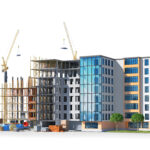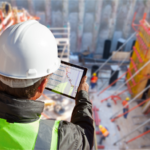Mission-critical construction is a broad category comprising many kinds of government and commercial facilities that must maintain non-stop operation in service of strategic public or business goals.
Four of the most vigorous categories of commercial mission-critical construction are advanced manufacturing, healthcare, data centers, and life sciences. Fueled by insatiable demand and fostered by aggressive capital investment and subsidies, these “Big Four” are proving to be less economically inhibited than many longer-established construction categories and thus are commanding outsized attention from construction companies and investors alike. This is vividly evidenced by the recent restructuring of the largest US construction firm for increased focus on biopharma facilities, data centers, and sustainability-related manufacturing.
Underscored by real estate services giant JLL’s research, these segments are far more impacted than traditional construction by four key risk factors:
- Larger, more complex projects
- More intense schedule pressure
- Greater supply chain uncertainty
- Increased skilled labor shortage
Most Big Four projects are megaprojects, often spanning millions of square feet and costing billions of dollars. And their systems for power, heating, cooling, networking, input and waste management, safety, and security are orders of magnitude more complex than those in residential, office, retail, hospitality, and other conventional building categories. Such complexity at such scale presents unprecedented challenges in project planning, engineering, and management that even the largest firms struggle to meet.
Challenges in Complexity, Scale, Supply Chain, and Labor
The construction urgency driven by demand is shared by all of the Big Four. And for some it is further intensified by market and geopolitical competition, as exemplified by data center, chip fab, battery and EV factory, and other projects critical to AI leadership, sustainable energy, and industrial productivity. These kinds of buildings can’t be built fast enough to satisfy demand, with average data center construction schedules, for example, being slashed by up to 80% in the past few years.
Also, while supply chain uncertainty remains a persistent concern across the entire construction industry, nowhere is it more critical than in Big Four projects. For example, data center competition and lingering supply chain latency has driven the delivery schedules for specialized high voltage switch gear to a year or more (which may get worse due to possible import tariffs). Conversely, the rapidly evolving technologies for battery manufacturing are causing design engineers to specify selected components far later in the construction schedule than for well-established manufacturing process components.
Finally, for the industry at large, general labor shortages are a pernicious problem that could get worse due to the already sluggish replenishment of an aging workforce possibly being further slowed by stricter immigration controls. However, for Big Four projects the labor shortage problem is extreme on multiple fronts. The sheer scale of these projects demands more workers of all kinds, but their complexity also creates a larger demand for advanced engineering and trade skills. And tight schedules, unpredictable equipment procurement and deliveries, and limited skills supply, make effective workforce planning and management all the more difficult, especially for specialty contractors.
The Growing Role of Engineering and MEP Firms
A subtle, but significant difference between conventional construction projects, even large ones, and Big Four mission-critical megaprojects is the importance of design engineering firms and specialty contractors. But for data centers, semiconductor factories, and other mission-critical megaprojects that is far from the case. Designing such buildings is a complex project within a complex project and the specialty skills required to implement those designs requires a large workforce of highly skilled MEP teams that must be carefully coordinated and managed.
As one specialty skills sourcing company summarizes the situation in an article titled “Mission Critical Facilities: High Demand for MEP Design Engineers”:
Companies need professionals who can design, implement, and manage the sophisticated systems that keep these facilities running without a hitch. Working in this field requires a unique set of essential skills and qualifications, these include:
- A thorough understanding of critical infrastructure: This includes the electrical, mechanical, and structural systems that are vital to these facilities. HVAC system knowledge is essential.
- Experience with redundancy systems: Ensuring there are backup plans in place to maintain operations during any failures is crucial. HV design and power systems skills are essential, specifically backup systems to prevent downtime
- Specific sector experience: Hands-on experience in data centers, healthcare labs, and clean rooms is highly valued.
- A focus on sustainability and energy efficiency: Engineers need to integrate sustainable practices and energy-efficient solutions into their designs.
- Strong commercial and technical skills: Engineers should have robust technical knowledge and commercial awareness to effectively implement new technologies.
And while the preponderant shortage of construction trade skills hits mission-critical projects particularly hard due to their scale, their complexity further broadens the challenges faced by MEP firms, as shown in this summary from an article by DEWALT Construction Technology:
MEP Industry Challenges
Complex Coordination: Integrating mechanical, electrical, and plumbing systems is challenging and can lead to costly clashes and delays.
Labor Shortage: Skilled trade shortages cause delays and rising costs, worsened by an aging workforce and limited new talent.
Regulatory Compliance: Meeting varied regional regulations is difficult, with non-compliance risking fines and delays.
Energy Efficiency: Growing demand for sustainable systems requires constant adaptation and significant resources.
Shifting Priorities in Megaprojects
It is becoming increasingly clear that MEP firms have greater importance and greater challenges in the Big Four mission-critical megaproject segments than they have had in their more subordinate role in traditional construction. As a planning and scheduling executive in a very large US general contractor active in mission-critical construction put it, on background for this article,
“On these projects, the MEPs are the most important stakeholders, and it is the GC’s job to ensure their success, not the other way around.”






